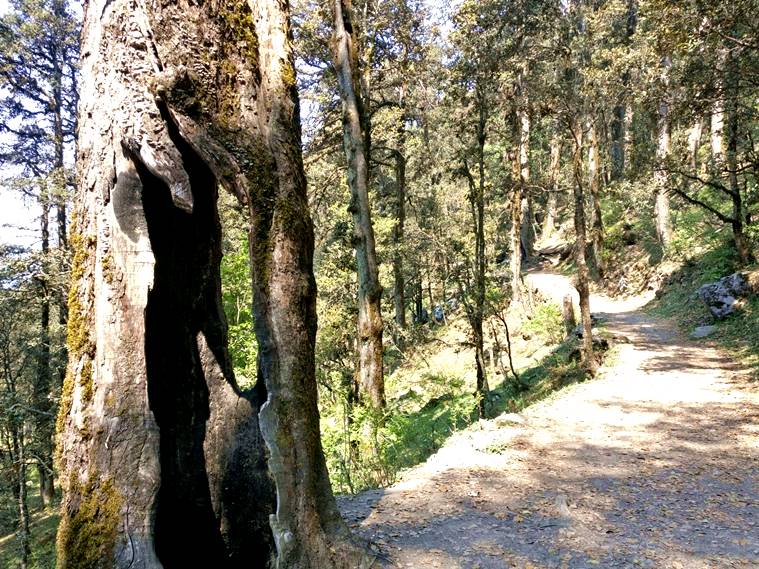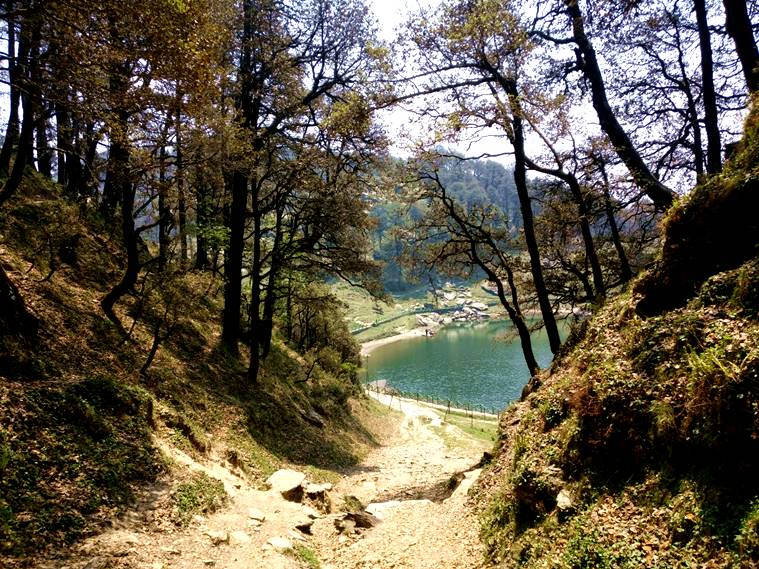 The hills aren’t well: Views of Jibhi, where residents are waiting for a tourism boom. (Source: Express Photo by Aniruddha Ghosal)
The hills aren’t well: Views of Jibhi, where residents are waiting for a tourism boom. (Source: Express Photo by Aniruddha Ghosal)
Shimla has run out of water. Kullu and Manali aren’t too far behind. There’s only so much tourism onslaught a hill station can take. Yet, Jibhi, a hamlet in Banjar valley in the Kullu district, about 40 km from Shimla, continues to wait for the inevitable stream of tourists, with equal parts dread and hope.
In spite of being criss-crossed by streams that gush past, cutting across untouched pine forests, the valley faces an unprecedented water crisis. The streams that flow through the valley and feed the Beas river are shallow. It hasn’t snowed in two years and the Himalayan trout has reduced in numbers, acccording to local fishermen. The yields from farming of crops ranging from garlic to wheat has been decreasing. Forest fires have become more frequent. Recently, a petition was filed with the National Green Tribunal alleging that these fire farmers had the timber mafia behind them. The imminent tourism boom will only make matters worse, everyone agrees. But for the valley, it remains the only hope for a better future.
“There aren’t any jobs in the valley. With the nearby Great Himalayan National Park being declared a World Heritage site in 2014, we were expecting more tourists. The numbers have increased, but it’s not enough. We are anticipating a bigger boom, as other hill stations are getting too crowded and running out of water,” says Yuvraj Thakur, 28, who is building a pinewood cottage with four rooms on his land.
 A petition was filed with the National Green Tribunal alleging that these fire farmers had the timber mafia behind them. (Source: Express Photo by Aniruddha Ghosal)
A petition was filed with the National Green Tribunal alleging that these fire farmers had the timber mafia behind them. (Source: Express Photo by Aniruddha Ghosal)
At an elevation of about 5,000 ft, marked by pine and deodar forests that brim with 181 species of birds, and with temperatures hovering around 20 degrees Celsius in the summer, Jibhi has all the trappings of a “hill station” — that colonial invention which evokes ideas of solace and offers the cool comfort of distance from northern India’s relentless summer. The only thing Jibhi lacks is tourists. Hopefully, all of that is set to change.
If Kullu, the district headquarters, is a hill station teeming with hotels that drain vital resources, Jibhi is the opposite. With a population of 500 in the valley, as per the district administration, tourists here are mostly trekkers looking to explore the pristine pine forests. Already, there are at least six homestays and campsites that have been set up — collectively capable of housing the entire valley’s population. The Himachal Pradesh Homestay Scheme mandates that any house in rural Himachal qualifies under the scheme, as long as it has at least one more room with attached bathrooms, for the purpose. “Everyone knows that tourism will pick up inevitably — the peak season stretches from the summer months till the rains begin in July, and then the months of September and October. But the big problem here is the challenge of setting up a homestay. The initial investment is massive and has to be done by the owner. So only those who have capital can build a homestay. Most people have taken out loans and we are dependent on tourists coming in to ensure that we can pay that back. It is only later that the state government steps in and provides support,” says Thakur.
At Jibhi, the nascent tourism ecosystem — taxi drivers, hoteliers and camp owners — has already taken steps to develop a system of self-regulation that might offset any adverse effect of uncontrolled tourism. A WhatsApp group serves as the prime mode of communication for an as yet unnamed association. “Different people have different concerns and we share it on the group and try to do as much regulation as possible. For instance, if we find someone fishing without a permit, or, if someone is found logging illegally, we alert the authorities,” says Tejinder Singh, who runs Jibhi’s lone café.
 At Jibhi, the nascent tourism ecosystem has already taken steps to develop a system of self-regulation. (Source: Express Photo by Aniruddha Ghosal)
At Jibhi, the nascent tourism ecosystem has already taken steps to develop a system of self-regulation. (Source: Express Photo by Aniruddha Ghosal)
About 10 km away from Jibhi, at Jalori Pass, a mountain pass at an elevation of nearly 11,000 feet, many shepherds have given up their traditional pastoral work in favour of setting up small cafés for trekkers. The menu typically features Maggi and black coffee alongside the Himachali siddu — a stuffed local bread. Govind Singh, who runs a “three-star café” says, “We still have some goats but there just isn’t enough money in grazing. With temperatures rising and the streams drying out, we have more cases of predators hunting our flock. Those result in losses that a poor man like me can’t handle. Selling Maggi and coffee is much more sustainable.” Singh says that what sells the most is bottled mineral water, preferably ones that claim its origins to be the high mountains.
Climate change is rarely articulated and its effects are, on many occasions, vaguely attributed to fate. The effects of that same “fate” can also lead you to nearby Chaini village. Famous in the area for its 17th century tower temples, this village has seven tubewells, two cafés and 28 homes as per district records and a solitary guest house is being constructed. What it doesn’t have is any water.
Six-year-old Tipu, a resident of the village, is used to being left alone in the shade of the main Chaini temple tower, clutching the keys to her house while her parents make the trek downhill to fetch water from Jibhi valley in buckets. Three trips are usually required for the family to get enough water for the day. Eventually, her mother arrives, holding a jug of water. Tipu reaches out eagerly and gulps down as much water as she can.